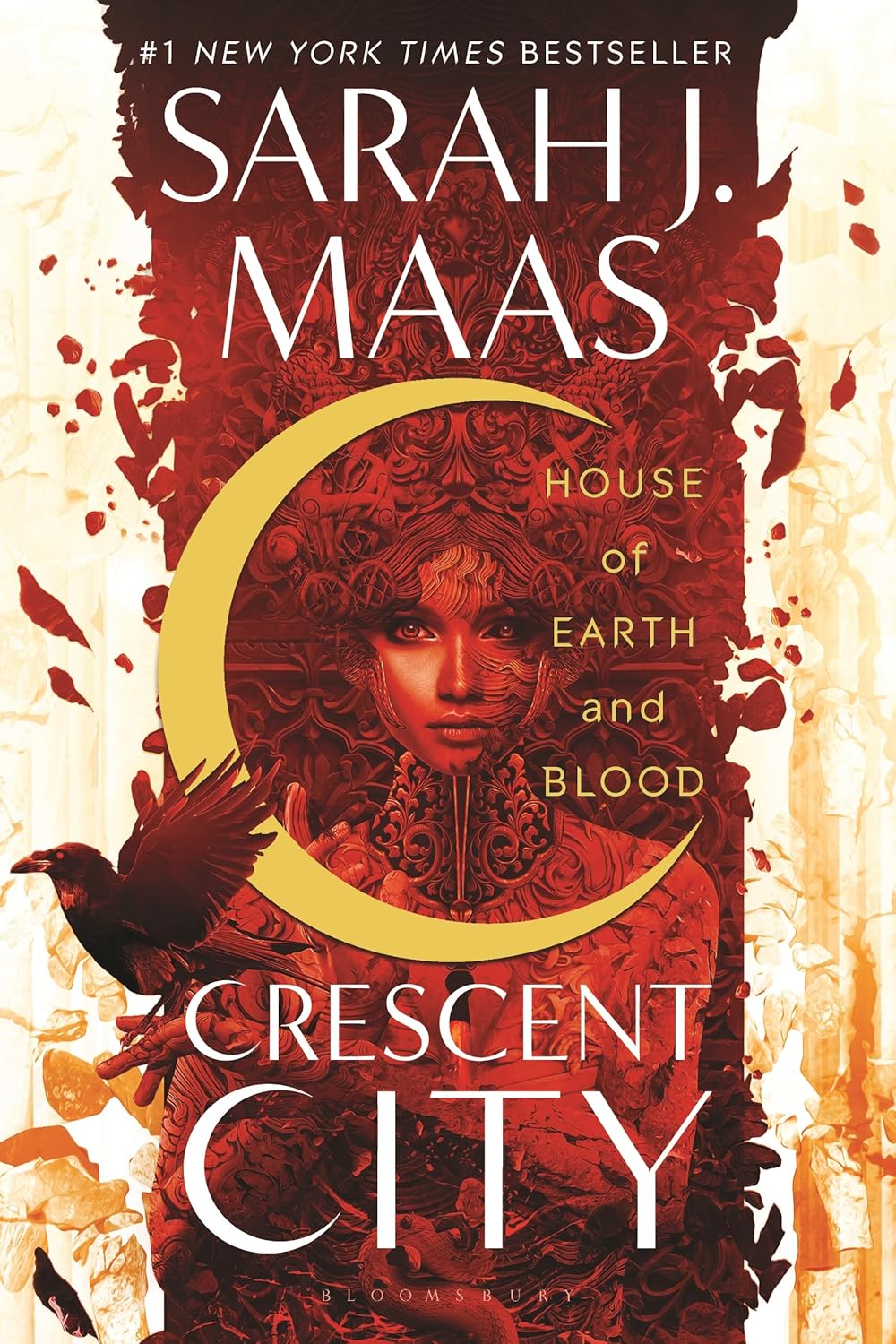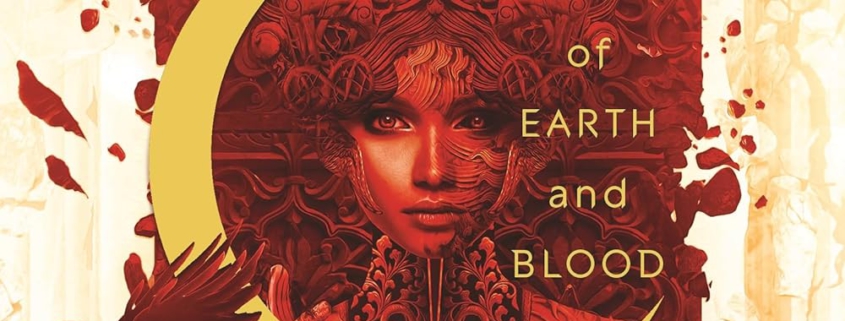In-Depth Review: House of Earth and Blood
In-Depth Review: House of Earth and Blood (Crescent City Book 1) by Sarah J. Maas
By Nandy
Synopsis

House of Earth and Blood introduces readers to the sprawling, modern-fantasy metropolis of Lunathion (Crescent City), where humans coexist with supernatural beings like fae, angels, shifters, and demons. The story follows Bryce Quinlan, a half-human, half-fae party girl whose life unravels when a demon murders her closest friends, including her fiery wolf-shifter best friend Danika Fendyr. Two years later, the killings resume, and Bryce is thrust into an investigation alongside Hunt Athalar, a enslaved Fallen angel with a lethal reputation. Their partnership—initially fraught with tension—evolves as they uncover a conspiracy threatening the city’s fragile peace. Alongside a murder-mystery plot, the novel explores themes of grief, loyalty, and redemption, all set against a backdrop of political intrigue and magical warfare.
The world-building is a blend of ancient hierarchies and modern technology: skyscrapers house dragon-led businesses, angels wield smartphones, and clubs thrum with neon-lit debauchery. However, Maas’s choice to include real-world elements (e.g., pizza, SUVs, texting) alongside fantasy jargon (e.g., firstlight, soul-light) polarized readers, with some praising its accessibility and others finding it jarring. The city is divided into districts ruled by seven Heads, including the Autumn King (fae), the River Queen (mer), and the Under-King (reapers), creating a layered political landscape that mirrors real-world issues of power and oppression.
Author Background
Sarah J. Maas is a #1 New York Times bestselling author renowned for her Throne of Glass and A Court of Thorns and Roses series. Known for intricate world-building and morally complex characters, Maas has sold over 30 million copies of her books worldwide. House of Earth and Blood marks her venture into adult urban fantasy, blending her signature romantic tension and high-stakes drama with a modern setting. Critics often note her ability to craft emotionally resonant narratives, though her works occasionally polarize readers due to their length and dense lore.
Maas has cited the film score “Shenzhou” from Gravity as inspiration for the book’s climactic scene, which she conceptualized during a flight while listening to the track. Her transition from YA to adult fantasy is evident in the mature themes of Crescent City, including graphic violence, explicit scenes, and explorations of addiction and PTSD.
Critical Analysis
1. Plot Structure and Pacing
The novel’s 803-page length is both a strength and a weakness. The first 200 pages are heavily dedicated to world-building, introducing Lunathion’s hierarchical society, governed by seven powerful Heads (e.g., the Autumn King, the River Queen). While essential, this setup can feel overwhelming, with readers comparing it to “drinking from a firehose” due to the barrage of terms like Vanir (supernatural beings), The Drop (a magical rite of passage), and Asteri (ancient rulers).
However, once the investigation gains momentum, the pacing accelerates into a suspenseful, multi-layered mystery. The final third delivers Maas’s trademark explosive climax, featuring revelations about Bryce’s heritage, Danika’s secret sacrifices, and a showdown with ancient evils. The payoff rewards patient readers, though some twists—like Danika’s hidden agenda—feel abrupt, relying on withheld information rather than organic foreshadowing.
2. Character Development
- Bryce Quinlan: Initially portrayed as a hedonistic party girl, Bryce’s layers are peeled back to reveal vulnerability and resilience. Her journey from self-destructive grief to empowerment is compelling, though her “too-cool-for-school” demeanor occasionally alienates readers. Critics note her relatability as a flawed protagonist who grapples with survivor’s guilt and societal expectations, particularly regarding her curvy physique and failed dance career.
- Hunt Athalar: A brooding antihero with a tortured past, Hunt’s evolution from mercenary to reluctant ally is nuanced. His dynamic with Bryce—a slow-burn romance blending banter and mutual trauma—anchors the emotional core of the story. However, some readers found him underdeveloped compared to Maas’s past heroes like Rhysand (ACOTAR).
- Supporting Cast: Standouts include Danika Fendyr (Bryce’s fiercely loyal best friend, whose posthumous role drives the plot), Ruhn Danaan (Bryce’s estranged half-brother, offering glimpses into fae politics), and Lehabah (a scene-stealing fire sprite whose sacrifice becomes a tear-jerking highlight). The pet chimera Syrinx adds levity, while villains like Micah Domitus and the Autumn King embody systemic corruption.
3. Themes and Symbolism
- Grief and Healing: Bryce’s struggle with survivor’s guilt and Hunt’s redemption arc underscore the novel’s exploration of loss. The mantra “Through love, all is possible” becomes a thematic anchor, emphasizing resilience and the transformative power of connection.
- Power and Oppression: The hierarchy of Crescent City mirrors real-world issues like systemic inequality. The enslavement of beings like Hunt critiques authoritarianism, while human rebels (e.g., the Ophion) highlight resistance against magical elitism. The Asteri, ancient rulers manipulating events from the shadows, symbolize unchecked corporate and political power.
- Friendship vs. Betrayal: Bryce and Danika’s bond transcends death, serving as the narrative’s emotional backbone. Conversely, betrayals by characters like Jesiba Roga (a morally ambiguous art dealer) complicate trust, reflecting the series’ nuanced take on loyalty.
4. World-Building and Setting
Lunathion is a vibrant fusion of modernity and magic: skyscrapers house dragon-led businesses, angels wield smartphones, and clubs thrum with neon-lit debauchery. However, Maas’s choice to include real-world elements (e.g., pizza, SUVs) alongside fantasy jargon (e.g., firstlight, soul-light) polarizes readers. Some praise its accessibility, while others find it jarring.
The magic system remains loosely defined, prioritizing emotional impact over rigid rules. Concepts like The Drop (a life-risking ritual to harness power) and synth (a magical drug) add texture but lack depth, leaving room for exploration in sequels. The inclusion of modern technology—such as surveillance systems and synthetic drugs—creates a unique contrast with ancient magical traditions, though critics argue this blend occasionally disrupts immersion.
Reception and Controversies
The book holds a 4.3/5 average on Goodreads, with praise for its emotional depth and critiques of its pacing:
- Positive Reviews: Readers laud the “heart-wrenching” friendships, unpredictable twists, and Maas’s growth in tackling mature themes like addiction and PTSD. Many cite the final 200 pages as a masterclass in cathartic storytelling, with Lehabah’s sacrifice and Bryce’s climactic Drop leaving lasting impressions.
- Negative Reviews: Critics cite the “exhausting” info-dumps, uneven pacing, and Hunt’s underdevelopment compared to Maas’s past heroes. The reliance on withheld information for plot twists (e.g., Danika’s secret plan) is seen as a narrative shortcut.
- Controversies: The inclusion of modern slang and technology (e.g., texting) in a fantasy setting sparked debate, with some calling it innovative and others dissonant. Additionally, the depiction of Bryce’s hedonistic lifestyle and casual sex drew mixed reactions, though many applauded its unflinching realism.
Personal Opinion
As a longtime Maas fan, I found House of Earth and Blood to be a flawed masterpiece. The first half’s sluggishness is offset by the latter’s emotional crescendo, particularly Danika’s sacrificial legacy and Lehabah’s tragic end. While Hunt and Bryce’s romance lacks the slow-burn perfection of ACOTAR’s pairings, their chemistry feels raw and relatable, anchored by shared trauma and witty banter.
The novel’s ambition—to marry urban grit with epic fantasy—is commendable but uneven. Newcomers may struggle with the dense lore, but patient readers will find a richly rewarding narrative that sets the stage for an even grander sequel, House of Sky and Breath. Maas’s willingness to experiment with genre-blending (mystery, romance, political thriller) showcases her evolution as a writer, even if the execution occasionally falters.
Publication Details
- Title: House of Earth and Blood (Crescent City Book 1)
- Author: Sarah J. Maas
- Publisher: Bloomsbury Publishing
- Publication Date: March 3, 2020
- Pages: 803
- ISBN: 978-1635574043
- Genres: Urban Fantasy, Romance, Mystery
- Content Warnings: Graphic violence, explicit sexual content, substance abuse, depictions of slavery, and themes of grief and suicide
Who Should Read This Book?
- Fans of Epic Fantasy: Lovers of intricate worlds like Throne of Glass will appreciate Lunathion’s depth, though the modern twist may require adjustment.
- Romance Enthusiasts: Those craving slow-burn, enemies-to-lovers dynamics will find Hunt and Bryce’s relationship compelling, albeit less polished than Maas’s prior pairings.
- Mystery Buffs: Readers who enjoy layered whodunits with supernatural twists will relish the conspiracy-driven plot, despite its convoluted setup.
- Content Note: Contains graphic violence, explicit scenes, and themes of addiction—best for mature audiences.
Conclusion
House of Earth and Blood is a bold, ambitious opener to the Crescent City series. While its pacing and world-building may daunt newcomers, its emotional payoff and character-driven narrative cement Maas’s status as a fantasy powerhouse. For readers willing to invest in its sprawling vision, the novel offers a gripping blend of heartbreak, magic, and resilience—a testament to the enduring power of love and friendship in the face of darkness.
Rating: ★★★★☆ (4/5)
Recommendation: A must-read for Maas devotees and urban fantasy fans, with patience advised for its slow burn. Newcomers should consider starting with ACOTAR or Throne of Glass to acclimate to her style.
Further Exploration
For deeper insights, explore fan theories about connections to Maas’s other series, or dive into the Crescent City Wiki for maps, character bios, and trivia about the inspiration behind Lunathion.
- Review Lost Girls: An Unsolved American Mystery by Robert Kolker
- Review: House of Earth and Blood by Sarah J. Maas
- Review: House of Sky and Breath by Sarah J. Maas
- Review: House of Flame and Shadow by Sarah J. Maas
- Review: Let Them Theory
- Review: Great Big Beautiful Life (Reese’s Book Club)
- Review: Sunrise on the Reaping
- Review: The Lost Bookshop



